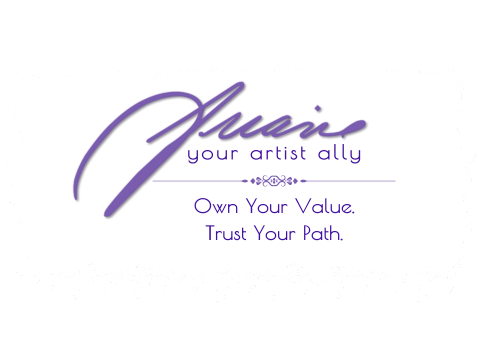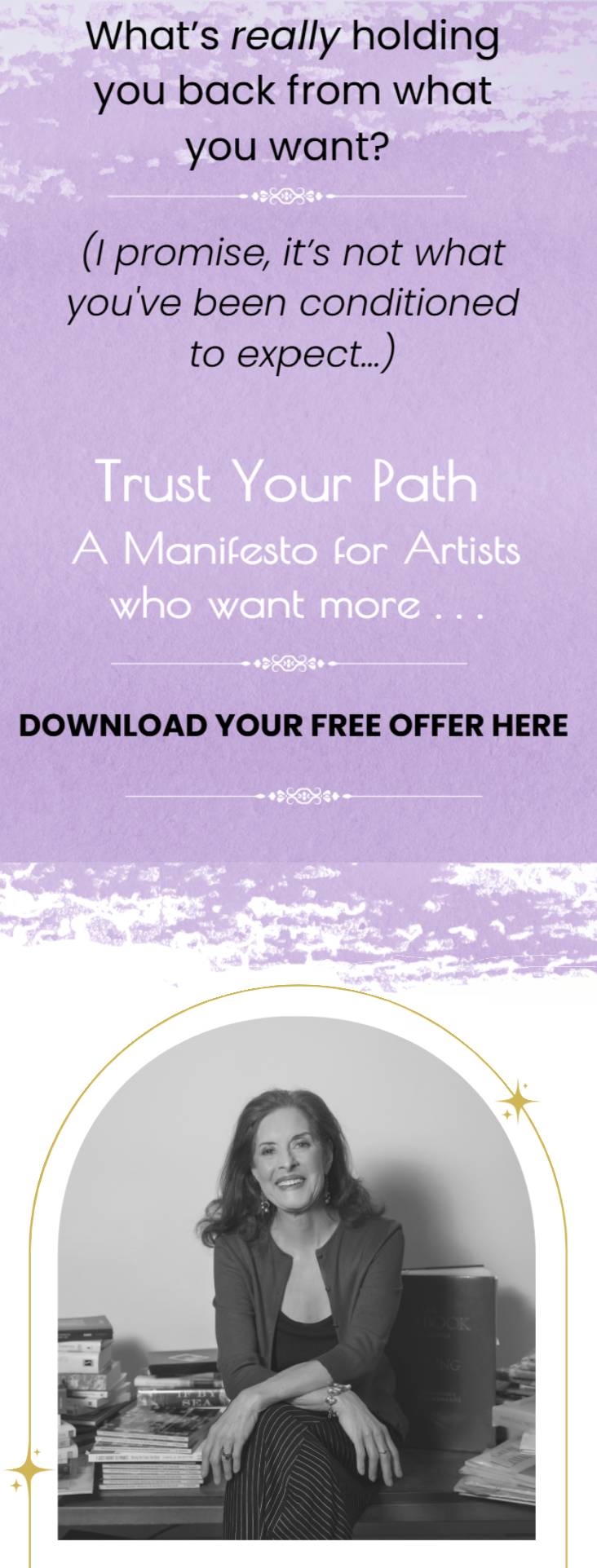![In gratitude…and pretty please would you…]()
by Ariane Goodwin PhD | Jan 24, 2022 | Uncategorized
I’m taking a breather after the mad rush of my Holiday Bonus, which I paired with a purchase of my book, Writing the Artist Statement: Revealing the True Spirit of Your Work.
It was a roaring success and I want to thank everyone who jumped in!
Now, my inner headlights are scanning the art career horizon for how I can best support your art career right now.
I have a couple of ideas, but what I really need is to hear from you about what you really, really need.
So, I’m crafting a short survey with questions aimed at just this: how to best support you and your art career.
If you have one or more questions you would like me to ask in this survey, please either 1) send me an email or 2) post a comment here on my Reflections Blog.
Remember, revealing the true spirit of your work…is the work,
even in challenging times,

Your Truth. Your Power. Your Word. Claim it!
P.S. One area I’m thinking about is mindset/stumbling blocks to either your creativity, your production ability, or the business side of your career.
Another is a hands-on workshop to write your Artist Statement, and/or Art Statements for individual collections/installations/or a series.
What do you think?
![In gratitude…and pretty please would you…]()
by Ariane Goodwin PhD | Jan 11, 2022 | Uncategorized
Ariane Goodwin, Ph.D.
An Educator, Editor, Writer, and Art Career Coach
who believes artists change the world!
Part 2: Getting Personal, Being Real
Getting personal and being real is really pretty simple when you write about you and your art.
Sometimes, it’s helpful to clear out the writing weeds… so…
First, what it’s not:
It’s not the therapy-style of baring-your-soul.
It’s not the I-love-you-and-need-to-tell-you-everything hashtag.
It’s not the because-I-need-love-I’ll-cut-open-a-vein-for-you hashtag.
Or winging it because you’re going for the informal look.
In an artist statement, getting personal and being real is limited; it’s focus is on your relationship to your art where your feelings, preferences, and vision can offer a potential collector what I call a “peek behind the canvas (or potting wheel, or marble, or cello…).”
The key here is “a peek.” You don’t need much in an artist statement that is only three paragraphs long (best case scenario), or even one page long (not the most desirable, but can work). And your reader only needs enough to feel as if you, like them, are real.
Sometimes it’s as simple as connecting a daily task to what you do:
Waking up before sunrise, rolling out of bed, one of the first imagines to rise in my consciousness is where I left off last night with my newest piece, Sky High.
That’s the spirit of how you want to connect.
There’s also a couple of writing techniques that, by their nature, open the door to getting personal and being real.
The first is the all-important I: first person.
This one can get tricky, especially if you are harboring obvious or hidden places where you lack confidence in your work.
Speaking in the first person, especially when you are writing, is saying: this is me. I stand in my truth wholly, fully, completely.
And sometimes, for some artists, first person be unnerving—anything from a slight discomfort to downright panic. It’s the most vulnerable position you can take.
And it’s essential you do.
Because, if you use third person, your statement sounds like a critic wrote it, and you are not a critic. Or it sounds as if an academic wrote it, but you are the artist (even if you also happen to be an academic).
It’s your work, not their work. So, owning it is actually the first step.
The second technique is specificity.
When you use generalities or overworn language, you immediately become no one (or everyone). Even if your art is fully original, with a well-developed fingerprint, if the language you use in your artist statement contradicts that, you immediately create dissonance in the mind of your potential collector.
Compare this:
As I shape the clay, I’m drawn into the pot as if I’m in a dream.
With this:
As the wet clay cools my palm, the emerging pot draws me into a rhythmic dream where the smell of clean earth rises ‘round me.
With word specificity, you can capture the same uniqueness that your art exudes.
That’s it.
You can interweave these three simple elements—a peek behind the curtain, first person, and specificity—with the core elements of your artist statement—the why, how, and why of your relationship to your art—and draw people even closer to the work that you love to make.
Remember, revealing the true spirit of your work…is the work,
even in challenging times,

Your truth. Your power. Your words. Claim it!
P.S. Want the whole system? And my Holiday Bonus– 10 Tips for a Perfect Artist Statement Presentation?
P.S. Remember, just for the holidays, I’m offering a HUGE Holiday Bonus when you buy my book, Writing The Artist Statement: Revealing the True Spirit of Your Work.
Ready for more? Click here!
Buy my book by the January 14th deadline:
Writing The Artist Statement:
Revealing The True Spirit Of Your Work
Ariane Goodwin, Ph.D.
The first & only complete resource book that works for visual artists at all levels: beginning / mid-career / advanced
My artistic partner is dyslexic, with a real writing phobia. Your book is a fantastic teaching air. The floodgates have opened and made him realize that he can write. What a godsend! ~J. Brett, London, UK
- Overcome writing blocks
- Avoid 7 blunders that tag you as an amateur
- Make your statement engaging and compelling
- Learn why galleries & collectors love good ones (even if you don’t)
- Use the power of sensory connection to help people remember you
- And get the Holiday Bonus: 10 Tips for a Perfect Artist Statement Presentation
Writing your statement has never been so easy! And that’s a promise…
- P.S.S. If you already have my book, but still want 10 Tips for a Perfect Artist Statement Presentation, send me an email: ariane@arianegoodwin.com
Revealing what, how and why you do your art does not dismantle either the beauty or mystery of it. Quite the opposite. Your effort to reach out invites others to participate in the mystery and to share the beauty.
—Ariane
by Ariane Goodwin PhD | Dec 22, 2021 | Uncategorized
1. Because an artist statement affirms what you do, and by extension affirms you.
And none of us can ever have too much affirmation.
2. Because an artist statement calls out for you to recognize the true faces of your deepest self: truth, beauty, and goodness.
And it’s about time, yes?
3. Because an artist statement invites you to experience another level of awareness about yourself and your art.
When you can update your own art experience, why wouldn’t you?
4. Because an artist statement strengthens the relationship you have with your work.
You may feel it’s pretty strong already, but I promise you’ll lift way above your level after writing your artist statement.
5. Because an artist statement builds a compelling bridge between your audience and your art.
Yes, your art is the real deal…but, if you can connect to your collectors on more than one level, why wouldn’t you?
6. Because an artist statement enriches the connection between the artist and the art.
Digging deep into the artist statement reveals more about your work than even you suspected. Surprise yourself!
7. Because it is practical. You can use your artist statement for:
8. Because it makes a deeper statement about self-trust, that you trust yourself enough to flow into another dimension of expression.
No matter how many “rational reasons” you come up with for not writing your statement, behind every one of them is a door marked “Fear.” Are you really going to let a little trepidation get in your way?
9. Because it is a powerful experience to use the tool of language to support what you love.
Even you use language when you think about your art, when you talk about your art…why not learn how to share some of that with the rest of us?
10. Because you can.
Mike drop!
=================================
I really don’t care which reason reaches into your psyche and moves you to action. All I care about is that you muster enough courage to reveal the true spirit of your work.
Just pick one and go for it!
Truth.. Power. Art.
BTW – if going for it feels more confusing than it should, check out my book.
Because I go to great lengths to make crafting your artist statement easy and satisfying, you only have to go to short lengths to get it done!
Want the whole system?
Writing The Artist Statement: Revealing The True Spirit Of Your Work – by Ariane Goodwin, Ph.D. the first & only complete resource book that works for visual artists at all levels: beginning / mid-career / advanced
- Overcome writing blocks
- Avoid 7 blunders that tag you as an amateur
- Make your statement engaging and compelling
- Learn why galleries & collectors love good ones (even if you don’t)
- Use the power of sensory connection to help people remember you
P.S. Writing your statement has never been so easy! And that’s a promise…
by Ariane Goodwin PhD | Dec 19, 2021 | Uncategorized
When you’ve read as many truly awful artist statements as I have, it begins to dawn on you that maybe, just maybe, the problem is at the very beginning before sliding down the slippery slope of awfulness.
What if accurately defining an artist statement was the first step, the very first step in writing a compelling, engaging statement that truly caught the attention of your viewers instead of making them yawn.
What if we start by answering the basic question: what the heck is it?
Here are 5 parts to that question:
1. What it does
2. Who it’s for
3. A definition
4. Why it’s all about you
5. A writing tip
Here are 5 parts to that answer:
1. The Sticky Factor: An effective statement creates a personal connection to the artwork and stimulates our human thirst for “story.” This, in turn, triggers… longer memory storage, and increases the sticky factor about your art, by immersing the viewer in two languages: visual and linguistic.
2. Not Just For Your Audience: Another secret is that the artist statement is not just for art patrons and gallery owners. It is also for you, the artist. The very effort of searching for words, which reflects your relationship to your art, increases your creative flow. This is true whenever we engage in a form of self-expression that pushes us out of our comfort zone. Like sweat from physical exertion, the struggle gets your juices flowing.
3. Defining An Artist Statement: Definition tells you if you’re headed in the right direction. It also saves a lot of angst and prevents you from unsightly fingernails. Here’s my definition: an artist statement is a personal reflection on what, how, and why you do what you do, from your perspective.
4. It’s About You: An artist statement is personal, as personal as your art. Your audience thinks you are magic and if they stand close enough, some of it will rub off. Let them stand close enough.
5. Details Matter: Because your artist statement originates in the written word, here’s a writer’s tip: use specific details in place of generalities. “A tree” becomes “A gnarled oak with one branch blackened from lightening.”
—————–
Have you written your artist statement? Or polished up an old one? Tell me, what was the hardest part for you?



